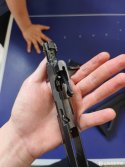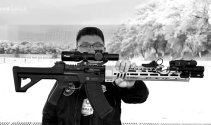Why is that, out of interest?What, are you sure? I could have sworn they did. Digital is terrible for military use.
You are using an out of date browser. It may not display this or other websites correctly.
You should upgrade or use an alternative browser.
You should upgrade or use an alternative browser.
QBZ-191 service rifle family
- Thread starter Blitzo
- Start date
That's not the case anymore. Digital NVG has reached at least Gen2+ light amplification with 100fps refresh rates.What, are you sure? I could have sworn they did. Digital is terrible for military use.
While that is true, the latency, battery life, and cost are lacking. However, after a couple of years at most or even eariler(the PLAGF seems to be set on digital NOD's), digital NOD's will most likely catch up to Gen 2+ (with a good fom of course) and may even have additional settings such as thermal.That's not the case anymore. Digital NVG has reached at least Gen2+ light amplification with 100fps refresh rates.
The SOF most likely want to develop TTP's with night fighting, and digital NOD's aren't good enough for that.Why is that, out of interest?
Latency is the main difference.. if there were really no downside to digital the US wouldn't be mass equipping so many analog NODs costing many times more. Also I've heard PLA SOF are generally equipped with analog.That's not the case anymore. Digital NVG has reached at least Gen2+ light amplification with 100fps refresh rates.
While that is true, the latency, battery life, and cost are lacking.
This is getting OT and probably better suited for the equipment thread. I'm using the ADNVG G14P2 as the benchmark for what a capable digital NOD can do. This video review of the unit has a segment on the latency along with some footage; the units gets well under 10ms of latency (down to low single digit in the test) and on casual inspection looks usable for combat and recon applications.Latency is the main difference.. if there were really no downside to digital the US wouldn't be mass equipping so many analog NODs costing many times more. Also I've heard PLA SOF are generally equipped with analog.
Agreed on OT, so I'll make a final response and opinion. I also used the ADNVG G14P2 as a benchmark and was definitely impressed by it. However, in regards to latency, while the initial footage is good, the problem is that it is too limited. The user didn't spin around with it and perform more maneuvers that one would do in an engagement or on austere terrain. So its latency quality is still up for question unless someone uses it extensively and records the performance.This is getting OT and probably better suited for the equipment thread. I'm using the ADNVG G14P2 as the benchmark for what a capable digital NOD can do. This video review of the unit has a segment on the latency along with some footage; the units gets well under 10ms of latency (down to low single digit in the test) and on casual inspection looks usable for combat and recon applications.
The battery life and cost are still a problem. The standard battery has a 5hr life. A larger battery with an extension tube gets 18hrs, but that adds weight and is unergonomic. This is a civilian product so cost isn't entirely comparable for a similar device commissioned by the PLA, but I don't imagine that even with SOE pricing this can get much below the cost of a low-end analog.
As for the cost, give it a couple years and it will go down. However, as of now, even low end analog NOD's still have advantages that gives them an edge over the G14P2, so this digital NOD still isn't worth it imo.
D


